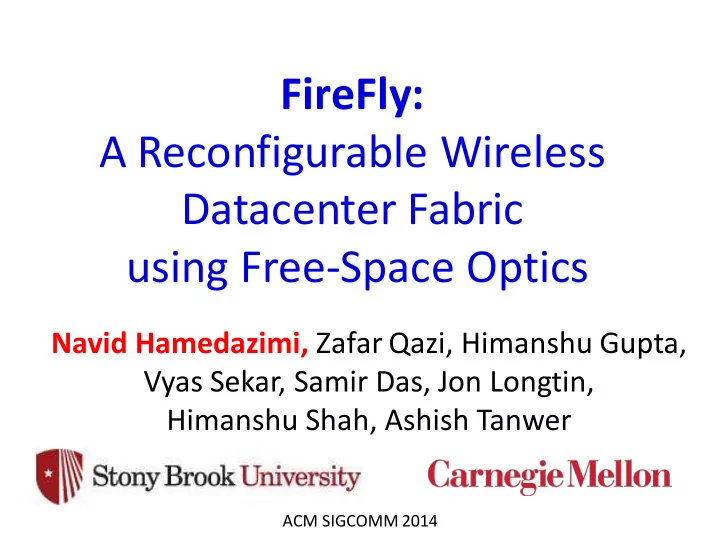

FireFly: A Reconfigurable Wireless Datacenter Fabric using Free-Space Optics Navid Hamedazimi, Zafar Qazi, Himanshu Gupta, Vyas Sekar, Samir Das, Jon Longtin, Himanshu Shah, Ashish Tanwer ACM SIGCOMM 2014
Datacenter network design is hard! Performance Cost Energy Cabling Expandability Cooling Adaptability 2
Existing Data Center Network Architectures Over subscribed Over provisioned (e.g. simple tree) (e.g. FatTree, Jellyfish) … … Augmented (e.g. cThrough) u … 3
Our Vision : FireFly ToR switch • Coreless Steerable Links • Wireless FireFly Controller • Steerable 4
Potential Benefits of This Vision Performance Cost Coreless Cabling Wireless Cooling Steerable Energy Expandability Adaptability 5
Challenges in Realizing the Vision ToR • Steerable wireless links switch • Network Design Steerable FSOs • Network Management FireFly Controller FireFly shows this vision is feasible 6
Outline • Motivation • Steerable Wireless Links • Network Design • Network Management • Evaluation 7
Why FSO instead of RF? RF (e.g. 60GHZ) FSO (Free Space optical) Wide beam Narrow beam High interference Zero interference Limited active links No limit on active links Limited Throughput High Throughput 8
Today’s FSO • Cost: $15K per FSO • Size: 3 ft³ • Power: 30w • Non steerable • Current: bulky, power-hungry, and expensive • Required: small, low power and low expense 9
Why Size, Cost, Power Can be Reduced? • Traditional use : outdoor, long haul ‒ High power ‒ Weatherproof • Data centers: indoor, short haul • Feasible roadmap via commodity fiber optics ‒ E.g. Small form transceivers (Optical SFP) 10
FSO Design Overview fiber optic cables SFP 11
FSO Design Overview Diverging beam SFP 12
FSO Design Overview Lens focal distance Parallel beam Focusing lens lens Collimating lens Large core fiber optic cables SFP • large cores (> 125 microns) are more robust 13
Steerability Shortcomings of current FSOs Cost FSO design Size using SFP Power Via Switchable mirrors • Not Steerable or Galvo mirrors 14
Steerability via Switchable Mirror • Switchable Mirror: glass mirror • Electronic control, low latency Ceiling mirror SM in “mirror” mode B C A 15
Steerability via Galvo Mirror • Galvo Mirror: small rotating mirror • Very low latency Ceiling mirror Galvo Mirror B C A 16
FSO Prototype in Data center Mirror Fiber holder and lens 17
FSO Link Performance • Effect of vibrations, etc. • 6mm movement tolerance • Range up to 24m tested 6 mm 6 mm FSO link is as robust as a wired link 18
Outline • Motivation • Steerable Wireless Links • Network Design • Network Management • Evaluation 19
How to design FireFly network? • Goals: Robustness to current and future traffic • Budget & Physical Constraints • Design parameters – Number of FSOs? – Number of steering mirrors? – Initial mirrors’ configuration • Performance metric – Dynamic bisection bandwidth 20
FireFly Network Design • # of FSOs = # of Servers • # of Switchable Mirrors = [10-15] for up to 512 racks or • # of Galvo Mirrors = 1 per FSO • Mirror Configuration = Random graph • less than ½ the ports of FatTree Projected Cost: 40% to 60% lower than FatTree 21
Outline • Motivation • Steerable Wireless Links • Network Design • Network Management • Evaluation 22
Network Management Challenges Ceiling Mirror • Reconfiguration ToR switch – Traffic engineering – Topology control Steerable • Correctness during flux FSOs FireFly Controller 23
FireFly Reconfiguration Algorithm • Joint optimization problem Massive ILP • Decouple – Traffic engineering Max-flow, greedy – Topology control Weighted Matching • Above is done periodically • In addition: Trigger-based reconfiguration – E.g. Create direct link for large flows 24
Correctness Problems During Flux • Connectivity • Black Holes C C C • Latency A B A B A B 25
Simple Rules To Ensure Correctness • Disallow deactivations that disconnect the network. • Stop using a link before deactivating it • Start using a link only after activating it • “Small” gap between reconfigurations 26
Outline • Motivation • Steerable Wireless Links • Network Design • Network Management • Evaluation 27
FireFly Evaluation • Packet-level • Flow-level (for large scale networks) • Evaluation of network in-flux • Evaluation of Our Heuristics 28
FireFly Throughput Throughput per server in Gbps i fireFly cThrough Fattree 10 8 6 4 2 0 hotspot (8) hotspot (16) Uniform Htsim simulator, 64 racks, three traffic patterns FireFly is comparable to FatTree with less than ½ the ports Flow completion time better than FatTree 29
Conclusions • Vision: Extreme DC network architecture – Fully Steerable, No core switches, All-wireless inter-rack • Unprecedented benefits: – No Cabling, Adapt to traffic patterns, Less clutter • Firefly shows a viable proof point – Practical steerable FSO for datacenters – Practical network design and management heuristics – Close to fat tree performance over several workloads – Less than half of FatTree ports • Just a start .. Many directions for improvement 30
Recommend
More recommend